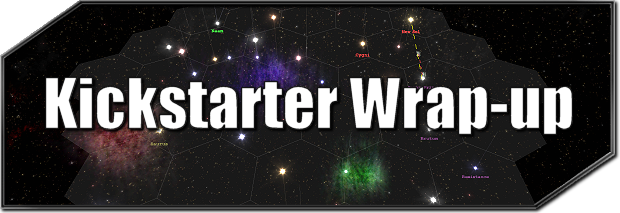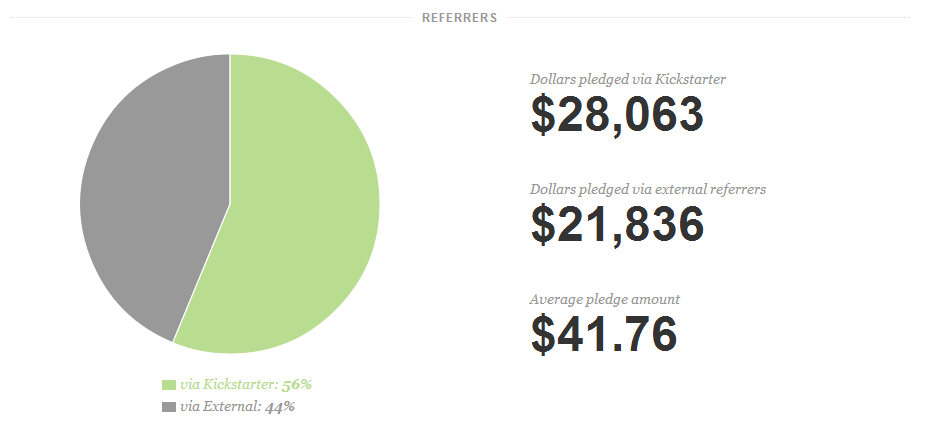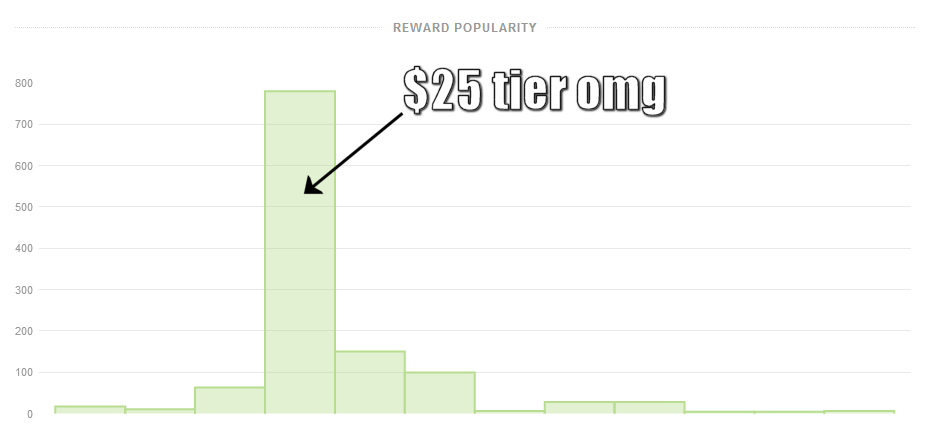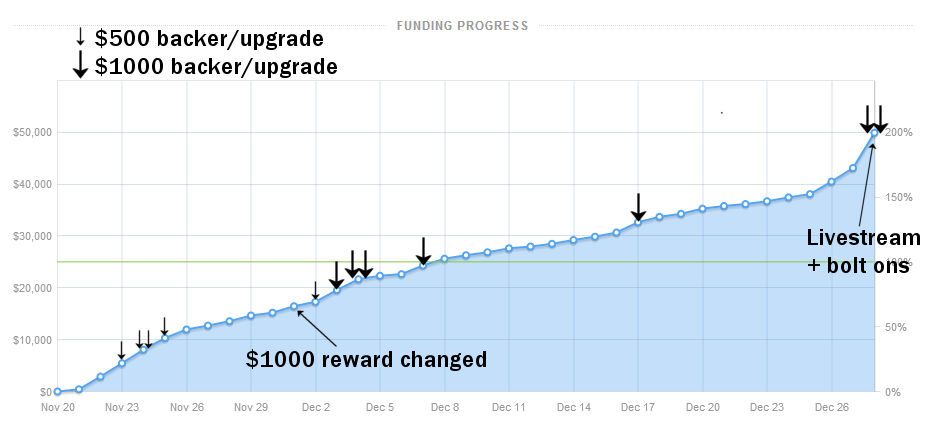Last week Predestination officially succeeded on Kickstarter! Thanks to a huge push in the last few days of the campaign, we managed to hit over double our initial goal and smashed the three biggest stretch goals. We’ll now have a full singleplayer story campaign, play-by-email and full online multiplayer for release.
We’ve decided to wrap up the campaign in the same spirit of transparency that we intend to keep up during Predestination’s development, so I’m releasing a ton of stats that are normally kept for the project creator’s eyes only and discussing some of the lessons we learned throughout the campaign. This kind of info from previous projects was invaluable when I was researching and putting together this campaign. I posted this originally as a Kickstarter update, but am posting it as a blog post so it can reach more future Kickstarter project creators. It’s a bit of a wall of text, but hopefully future Kickstarter creators will find it useful!
(More updates on the way)
How much does Kickstarter help?:
We were very surprised to see just how many pledges came from people browsing Kickstarter itself! Less than half of our pledges came from people following links from external sources like gaming blogs, social media, forums, google, and emails. Most pledges (421 backers contributing 36.47% of the total funds) came from the Video Games Discover page, and to be visible on that page you need to either be a staff pick or be in the top 15 most popular projects. We weren’t a staff pick, but floated in and out of the top 15 over the course of the campaign.
The lesson here is that if you get enough of your own funding quickly enough, you’ll get onto the Most Popular lists and Kicktraq and it will snowball from there. If you’re thinking of crowdfunding on your own website to cut out that 5-10% fee, think again! If you can secure enough of your own backing through traditional means, Kickstarter has its own organic community that will multiply it.
Backer rewards:
For game kickstarters, the most popular reward is always the lowest one with a copy of the game (usually $10, $15, or $20), but the most popular pledge across all of kickstarter is $25. Offering something good at $25 is essential, but just starting to offer the game at $25 could be too high if your game looks like it should be less than $25 at launch.
We decided to offer the game at the estimated launch price of $20, but added free DLC and expansions for life for just $5 extra. This just made the $25 pledge level a very good deal and so most people didn’t mind upgrading. Simply offering good value for money rewards really worked for us; we even added a free second copy of the game to the $40 beta access tier so that it was always good value for money to upgrade. As a side-effect, our graph now looks like a hand giving the middle finger! 😀
Media coverage:
Predestination wasn’t picked up by the mainstream media, so our main sources of media coverage were indie gaming blogs and the four sites listed above. Rock Paper Shotgun, Space Sector, Blue’s News and Space Game Junkie all sent more than 5 backers our way (everything below 5 is no longer available in the stats dashboard).
Kickstarter fatigue in the media: Though gamers are more excited than ever about crowdfunding games, most gaming websites are sick of hearing about Kickstarter. That’s why things like Rock Paper Shotgun’s weekly Kickstarter Katchup are amazing. RPS will cover almost any PC game that looks like it stands a chance and was a big source of backers for us. Blue’s News was one of the few sites we contacted that ran stories on us, and Space Game Junkie has been following Predestination for a while and posted about all of our updates.
I’d still advise people to mail all the big gaming media, but focus on niche sites and blogs first and encourage your backers to post about you on any forums they frequent. The GOG forums and Something Awful were good sources of pledges for us as we were already members and both forums have dedicated Kickstarter threads. Posting links to Reddit is a bit of a lottery, some moderators will shut down threads as self-promotion and some won’t. We found it better to just wait for threads to be started by backers and answer questions in them.
Day-1 media coverage: I cannot stress enough how much it helped to build up an audience before Kickstarter and get day-1 media coverage! Space Sector had been following Predestination all year, and its day-1 coverage gave us an immediate push into the Video Games Most Popular section on Kickstarter. We also collected email addresses for a beta mailing list last summer at QCon (Ireland’s biggest gaming convention) and a lot of our friends pledged in the first week. If you want a project to succeed, you really need a big boost of pledges on the first day/week to get into the Most Popular lists and Kicktraq.
Big pledges and adapting rewards:
Change unused tiers: One of the biggest surprises for us was how many people pledged for our $500 and $1000 tiers. The $500 level-design tier started selling almost immediately, but nobody went for our original $1000 reward (the backer’s name inscribed on a plaque that would sit in our main office). After a few weeks, I changed it to designing your own race and level and made an update about it.
Within a week, several $500 backers had upgraded and several new people had pledged $1000. The rush of thousand-dollar backers and upgrades pushed us up to Kicktraq’s Hot 7 and back into the Most Popular list on Kickstarter, which got us a lot more pledges. My advice to anyone running a Kickstarter campaign is to watch the rewards and change any that aren’t touched within the first week or two. Big rewards that offer some degree of authorship in the game like naming something or designing something are hugely popular.
Keep your videos short!:
My first attempt at a pitch video was around 10 minutes long, and we managed to cut it down to about 6 minutes before launch. That turned out to not be good enough: Only 14% of people were making it to the end of the video! We took a hacksaw to the video and cut it down to just three minutes, frontloading the important gameplay stuff so that the main features were shown within 30 seconds. The number of people who got to the end of the video quickly rose to 20%; I have no idea if this is still terrible, but the edits definitely helped.
The big finish, Jeff McCord style:
Every Kickstarter campaign gets a boost at the end when all those people who clicked the “Remind me” button get their 48 hour reminder email. We capitalised on that by having a new art update waiting for then and announcing that we’d be doing a livestream for the final 6 hours. We really enjoyed taking part in Jeff McCord’s recent Kickathon event, so we did our own mini version and reached out to some other space games on Kickstarter to invite them to the stream. We were joined by the creators of Skyjacker and Galcon 2 and generally had a lot of Irish banter and Q&A.
Was it worth the effort?: If anyone is still doubting that a finishing livestream is worth doing, I’ll just say that we got well over $7,000 in our final day and most of it was during the livestream. But it was worth it more for the experience than the funding: There was a tremendous buzz, with people really pushing for us to hit our next stretch goal and posting links everywhere they could. A livestream will put a lot of your most dedicated backers in one place, and it’s a really fun experience. I seriously recommend it for everyone ending a campaign!
Upgrades: We experimented with offering stream viewers some last-minute bolt-ons: Add $15 to your pledge to name a star, $35 to design a missile, and $50 to design a building. This gave people who wanted to pledge more a good reason to, and it got us a lot closer to 50k. As we started to approach the 50k mark, I gave regular updates on the total (including Paypal) and how much we had to go. One of our $500 backers Alexander Sharts upgraded to $1000 in the final hour to get us very close, and at the last minute Ninevah worked out how much we needed to hit 50k and pushed us over the line with a massive $941 pledge!
Every backer deserves your thanks!
The biggest lesson of all that we learned was that the Kickstarter isn’t ultimately about your game or the gaming media, it’s about the people who have enough faith in you to back your project. They’re your game’s first community and the people funding your dreams, and they deserve your personal attention even if it means Kickstarter is your full-time job for a month. I think giving each backer personal attention was a big part of why we succeeded.
We sent personal messages to every single new backer to welcome them and ask if they had any questions. Just starting that conversation is the first step toward creating a community, and led to people running ideas by us and becoming more confident in our game and goals. We made sure to respond to every mail and answer every question in the comments, and some of the backers had awesome ideas we hadn’t considered. It’s definitely worth starting that conversation with a quick message to every new backer!
Thank you 😀
Hopefully this information will be of use to people putting together Kickstarters in the future! If anyone has any questions, please leave them in the comments! I want to give a special thank-you to every one of our backers for not just supporting us but getting us all the way to 50k! It’s overwhelming to see so much support for Predestination, and we promise that we won’t let you down :D.
— Brendan Drain, Lead Developer












